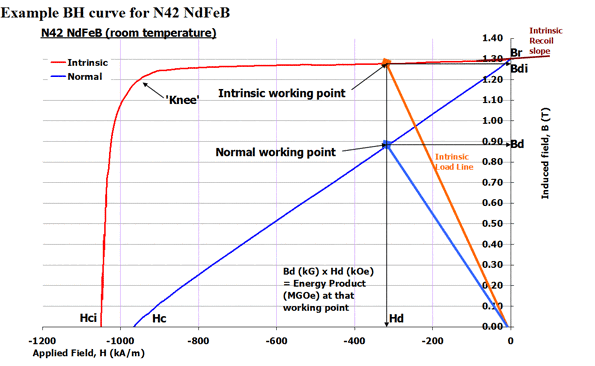NdFeB Magnet Grades
The Original Online Magnet Company
The NdFeB magnet grades nomenclature is simple.
They all start with "N" which simply stands for "Neo" (industry simplification of Neodymium) and is followed by a two digit number
This number represents the maximum energy product in Mega-Gauss Oersteds (MGOe) where 1MGOe (cgs units) equals 7958kJ/m3 (SI units). The range available used to be N24 up to N52. The lower NdFeB magnet grades are no longer made and the range now starts at around N30 or N33. N50 is the highest readily available grade. N52 is possible but only in certain sizes.
Although the maximum possible energy product is calculated in to be N64, it is unlikely such high strengths of Neodymium will be achievable in the near future (when the newest NbFeB grades are commercially available they are often available only for direct sale into military applications).
A suffix letter (or two letters) may then follow the number. It is stated that these letters (or lack of them) relate to a temperature rating. Strictly speaking, this is not correct. The letters actually indicate the Intrinsic Coercivity (Hci) of the material. The higher the Hci, the higher the temperature the Neodymium magnet material can be exposed to before the magnet will start to show permanent losses in output. It is this fact that is used to link the last letter(s) to a temperature rating.
The current range of Neodymium Iron Boron magnets is as follows:
N27, N30, N33, N35, N38, N40, N42, N45, N48, N50, N52, N30M, N33M, N35M, N38M, N40M, N42M, N45M, N48M, N50M, N30H, N33H, N35H, N38H, N40H, N42H, N45H, N48H, N30SH, N33SH, N35SH, N38SH, N40SH, N42SH, N45SH, N28UH, N30UH, N33UH, N35UH, N38UH, N40UH, N28EH, N30EH, N33EH, N35EH, N38EH, N33VH/AH.
NdFeB Magnet Grades References
The temperature rating for Neodymium is merely a guide value. It is the physical size and shape of the NdFeB magnet and the total magnetic circuit that actually determines how well a magnet will perform at a raised temperature. For example, a NdFeB magnet in free space will demagnetise at a lower temperature than the same sized NdFeB magnet connected to a piece of mild steel. It will also demagnetise at a lower temperature than a NdFeB magnet of twice the length in the direction of magnetisation. The Intrinsic curve shape also plays a part in the temperature performance of NdFeB.
The total magnetic circuit that the Neodymium magnet is in determines its working point on the Intrinsic curve. By having a higher working point (e.g. magnet connected to mild steel or a longer magnet) the magnet will cope with a higher temperature before it will show signs of demagnetisation (when the working point passes the ‘knee’ of the Intrinsic curve). The situation is made more unclear if an external demagnetising field is present as this may mean the Neodymium magnet may demagnetise at even lower temperatures.
Therefore, it is quickly apparent that the total magnetic circuit, the total environment and the application as a whole must all be reviewed to determine whether a Neodymium magnet will still perform at a satisfactory level towards the recommended maximum working temperature as indicated by the letter(s) in its NdFeB magnet grade classification. For example, a magnet rated for a recommended maximum working temperature of 150 degrees C, may start to demagnetise significantly at 100 degrees C if the design is poor, or a magnet rated for a recommended maximum working temperature of 80 degrees C may start to demagnetise significantly at 100 degrees C if the design is really good.
NdFeB Working Temperatures
The recommended NdFeB magnets' maximum working temperatures are indicators of likely performance but the user should review their design for suitability or contact us for design assistance. The letter nomenclature is as follows (where xx is the Maximum Energy Product in MGOe):-
Nxx 12000 Oe / 955kA/m (minimum)80 deg C / 175 deg F suggested maximum
NxxM 14000 Oe / 1115kA/m (minimum) 100 deg C / 212 deg F suggested maximum
NxxH 17000 Oe / 1355kA/m (minimum) 120 deg C / 248 deg F suggested maximum
NxxSH 20000 Oe / 1590kA/m (minimum) 150 deg C / 302 deg F suggested maximum
NxxUH 25000 Oe / 1990kA/m (minimum) 180 deg C / 356 deg F suggested maximum
NxxEH 30000 Oe / 2385kA/m (minimum) 200 deg C / 392 deg F suggested maximum
NxxVH / NxxAH 35000 Oe / 2785kA/m (minimum) 230 deg C / 446 deg F suggested maximum

Nomenclature of NdFeB Magnet Grades
| Chinese Standard - commonly used globally, especially in EU | |||||||||
| Minimum Values | |||||||||
| Material | Br | Hcb (Hc) | Hcj (Hci) | (BH)max | |||||
| mT | G | kA/m | Oe | kA/m | mT | G | kA/m | ||
| N27 | 1,030 | 10,300 | 796 | 10,000 | 955 | 1,200 | 119 | 25 | |
| N30 | 1,080 | 10,800 | 796 | 10,000 | 955 | 1,200 | 223 | 28 | |
| N33 | 1,130 | 11,300 | 836 | 10,500 | 955 | 1,200 | 247 | 31 | |
| N35 | 1,170 | 11,700 | 868 | 10,900 | 955 | 1,200 | 263 | 33 | |
| N38 | 1,220 | 12,200 | 899 | 11,300 | 955 | 1,200 | 287 | 36 | |
| N40 | 1,250 | 12,500 | 907 | 11,400 | 955 | 1,200 | 302 | 38 | |
| N42 | 1,280 | 12,800 | 915 | 11,500 | 955 | 1,200 | 318 | 40 | |
| N45 | 1,320 | 13,200 | 923 | 11,600 | 955 | 1,200 | 342 | 43 | |
| N48 | 1,380 | 13,800 | 923 | 11,600 | 955 | 1,200 | 366 | 46 | |
| N50 | 1,400 | 14,000 | 796 | 10,000 | 876 | 1,100 | 382 | 48 | |
| N52 | 1,430 | 14,300 | 796 | 10,000 | 876 | 1,100 | 398 | 50 | |
| N30 | M | 1,080 | 10,800 | 796 | 10,000 | 1,115 | 1,400 | 223 | 28 |
| N33 | M | 1,130 | 11,300 | 836 | 10,500 | 1,115 | 1,400 | 247 | 31 |
| N35 | M | 1,170 | 11,700 | 868 | 10,900 | 1,115 | 1,400 | 263 | 33 |
| N38 | M | 1,220 | 12,200 | 899 | 11,300 | 1,115 | 1,400 | 286 | 36 |
| N40 | M | 1,250 | 12,500 | 923 | 11,600 | 1,115 | 1,400 | 302 | 38 |
| N42 | M | 1,280 | 12,800 | 955 | 12,000 | 1,115 | 1,400 | 318 | 40 |
| N45 | M | 1,320 | 13,200 | 995 | 12,500 | 1,115 | 1,400 | 342 | 43 |
| N48 | M | 1,380 | 13,800 | 1,027 | 12,900 | 1,115 | 1,400 | 366 | 46 |
| N50 | M | 1,400 | 14,000 | 1,033 | 13,000 | 1,115 | 1,400 | 382 | 48 |
| N30 | H | 1,080 | 10,800 | 796 | 10,000 | 1,355 | 1,700 | 223 | 28 |
| N33 | H | 1,130 | 11,300 | 836 | 10,500 | 1,355 | 1,700 | 247 | 31 |
| N35 | H | 1,170 | 11,700 | 868 | 10,900 | 1,355 | 1,700 | 263 | 33 |
| N38 | H | 1,220 | 12,200 | 899 | 11,300 | 1,355 | 1,700 | 286 | 36 |
| N40 | H | 1,250 | 12,500 | 923 | 11,600 | 1,355 | 1,700 | 302 | 38 |
| N42 | H | 1,280 | 12,800 | 955 | 12,000 | 1,355 | 1,700 | 318 | 40 |
| N45 | H | 1,320 | 13,200 | 955 | 12,000 | 1,355 | 1,700 | 342 | 43 |
| N48 | H | 1,370 | 13,700 | 995 | 12,500 | 1,355 | 1,700 | 366 | 46 |
| N30 | SH | 1,080 | 10,800 | 804 | 10,100 | 1,590 | 2,000 | 223 | 28 |
| N33 | SH | 1,130 | 11,300 | 844 | 10,600 | 1,590 | 2,000 | 247 | 31 |
| N35 | SH | 1,170 | 11,700 | 876 | 11,000 | 1,590 | 2,000 | 263 | 33 |
| N38 | SH | 1,220 | 12,200 | 907 | 11,400 | 1,590 | 2,000 | 286 | 36 |
| N40 | SH | 1,250 | 12,500 | 939 | 11,800 | 1,590 | 2,000 | 302 | 38 |
| N42 | SH | 1,280 | 12,800 | 987 | 12,400 | 1,590 | 2,000 | 318 | 40 |
| N45 | SH | 1,320 | 13,200 | 1,003 | 12,600 | 1,590 | 2,000 | 342 | 43 |
| N28 | UH | 1,020 | 10,200 | 764 | 9,600 | 1,990 | 2,500 | 207 | 26 |
| N30 | UH | 1,080 | 10,800 | 812 | 10,200 | 1,990 | 2,500 | 223 | 28 |
| N33 | UH | 1,130 | 11,300 | 852 | 10,700 | 1,990 | 2,500 | 247 | 31 |
| N35 | UH | 1,180 | 11,800 | 860 | 10,800 | 1,990 | 2,500 | 263 | 33 |
| N38 | UH | 1,220 | 12,200 | 899 | 11,300 | 1,990 | 2,500 | 287 | 36 |
| N40 | UH | 1,250 | 12,500 | 899 | 11,300 | 1,990 | 2,500 | 302 | 38 |
| N28 | EH | 1,040 | 10,400 | 780 | 9,800 | 2,385 | 3,000 | 207 | 26 |
| N30 | EH | 1,080 | 10,800 | 812 | 10,200 | 2,385 | 3,000 | 223 | 28 |
| N33 | EH | 1,140 | 11,400 | 836 | 10,500 | 2,385 | 3,000 | 247 | 31 |
| N35 | EH | 1,170 | 11,700 | 876 | 11,000 | 2,385 | 3,000 | 263 | 33 |
| N38 | EH | 1,220 | 12,200 | 899 | 11,300 | 2,385 | 3,000 | 287 | 36 |
| N33 | VH / AH | 1,130 | 11,300 | 836 | 10,500 | 2,706 | 3,400 | 239 | 30 |
| American Standard | ||||||||
| Typical Values | ||||||||
| Material | Br | Hcb (Hc) | Hcj (Hci) | (BH)max | ||||
| mT | G | kA/m | Oe | kA/m | Oe | kJ/m3 | MGOe | |
| 24/41 | 1,000 | 10,000 | 764 | 9,600 | 3,263 | 41,000 | 190 | 24.0 |
| 26/32 | 1,050 | 10,500 | 803 | 10,090 | 2,507 | 31,500 | 205 | 26.0 |
| 28/23 | 1,050 | 10,500 | 820 | 10,300 | 1,830 | 23,000 | 225 | 28.0 |
| 28/32 | 1,073 | 10,730 | 835 | 10,490 | 2,507 | 31,500 | 225 | 28.0 |
| 30/19 | 1,130 | 11,300 | 859 | 10,800 | 1,512 | 19,000 | 240 | 30.0 |
| 30/27 | 1,130 | 11,300 | 859 | 10,800 | 2,149 | 27,000 | 240 | 30.0 |
| 32/16 | 1,180 | 11,800 | 891 | 11,200 | 1,273 | 16,000 | 255 | 32.0 |
| 32/31 | 1,160 | 11,600 | 883 | 11,100 | 2,467 | 31,000 | 255 | 32.0 |
| 34/22 | 1,196 | 11,960 | 915 | 11,500 | 1,771 | 22,250 | 270 | 34.0 |
| 36/19 | 1,231 | 12,310 | 917 | 11,520 | 1,523 | 19,140 | 285 | 36.0 |
| 36/26 | 1,220 | 12,200 | 931 | 11,700 | 2,069 | 26,000 | 285 | 36.0 |
| 38/15 | 1,250 | 12,500 | 955 | 12,000 | 1,194 | 15,000 | 300 | 38.0 |
| 38/23 | 1,240 | 12,400 | 955 | 12,000 | 1,830 | 23,000 | 300 | 38.0 |
| 40/15 | 1,280 | 12,800 | 955 | 12,000 | 1,194 | 15,000 | 320 | 40.0 |
| 40/23 | 1,290 | 12,900 | 987 | 12,400 | 1,830 | 23,000 | 320 | 40.0 |
| 42/15 | 1,310 | 13,100 | 1,011 | 12,700 | 1,194 | 15,000 | 335 | 42.0 |
| 44/15 | 1,350 | 13,500 | 1,035 | 13,000 | 1,194 | 15,000 | 350 | 44.0 |
| 48/11 | 1,375 | 13,750 | 820 | 10,300 | 875 | 11,000 | 380 | 48.0 |
| 50/11 | 1,410 | 14,100 | 820 | 10,300 | 875 | 11,000 | 400 | 50.0 |
| European Standard (IEC 60404-8-1) | |||||||||
| Minimum Values | |||||||||
| Material | Group code | Br | Hcb (Hc) | Hcj (Hci) | (BH)max | ||||
| mT | G | kA/m | Oe | kA/m | kOe | kJ/m3 | MGOe | ||
| 170/190 | R7-1-1 | 980 | 9800 | 700 | 8795 | 1900 | 23875 | 170 | 21.4 |
| 210/130 | R7-1-2 | 1060 | 10600 | 790 | 9925 | 1300 | 16335 | 210 | 26.4 |
| 250/120 | R7-1-3 | 1130 | 11300 | 840 | 10555 | 1200 | 15080 | 250 | 31.4 |
| 290/80 | R7-1-4 | 1230 | 12300 | 700 | 8795 | 800 | 10055 | 290 | 36.4 |
| 200/190 | R7-1-5 | 1060 | 10600 | 760 | 9550 | 1900 | 23875 | 200 | 25.1 |
| 240/180 | R7-1-6 | 1160 | 11600 | 840 | 10555 | 1800 | 22620 | 240 | 30.2 |
| 280/120 | R7-1-7 | 1240 | 12400 | 900 | 11310 | 1200 | 15080 | 280 | 35.2 |
| 320/88 | R7-1-8 | 1310 | 13100 | 800 | 10055 | 880 | 11060 | 320 | 40.2 |
| 210/240 | R7-1-9 | 1060 | 10600 | 760 | 9550 | 2400 | 30160 | 210 | 26.4 |
| 240/200 | R7-1-10 | 1160 | 11600 | 840 | 10555 | 2000 | 25130 | 240 | 30.2 |
| 310/130 | R7-1-11 | 1300 | 13000 | 900 | 11310 | 1300 | 16335 | 310 | 39.0 |
| 250/240 | R7-1-12 | 1200 | 12000 | 830 | 10430 | 2400 | 30160 | 250 | 31.4 |
| 260/200 | R7-1-13 | 1210 | 12100 | 840 | 10555 | 2000 | 25130 | 260 | 32.7 |
| 340/130 | R7-1-14 | 1330 | 13300 | 920 | 11560 | 1300 | 16335 | 340 | 42.7 |
| 360/90 | R7-1-15 | 1350 | 13500 | 800 | 10055 | 900 | 11310 | 360 | 45.2 |
Discover More
Get in touch today
Please do not hesitate to contact us with any question or query you may have. Our professional team will give you expert advice and guidance for your magnetic application and equipment.


